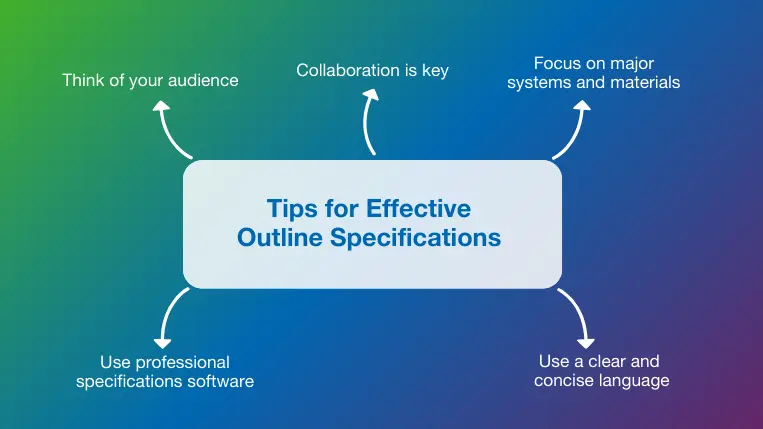10 mins read
Exploring Outline Specifications and Their Importance in Construction Projects

Construction specifications are a crucial component of the success of a project. They provide essential information about the materials, quantities, workmanship, systems, and all other elements needed to bring a building to life in the expected quality, time, and budget.
Depending on the project’s size and complexity, various types of specs might be developed to support different tasks. We already covered sheet specs, condensed versions of specifications included directly on drawings. Today, we’ll discuss the role of outline specifications and why they are crucial tools to guide the initial stages of a project.
What are Outline Specifications?
Outline specifications are preliminary specs prepared during a project’s schematic and design development stages. They contain brief descriptions of the project’s materials, components, and systems to support cost estimates and guide the design process.
Outline specs communicate design intent and establish general expectations for quality, performance, and scope. They help the different construction roles align on key decisions regarding costs and budgeting, material requirements, and more. They also serve as the foundation to guide the creation of detailed technical specifications as the project stages progress.
Outline specs are not mandatory in all construction projects unless the project follows specific guidelines, like the AIA B101–2007 agreement, where architects are contractually obligated to provide outline specifications during the Design Development phase. Other institutions, like banks or insurance companies, might also require them in projects with substantial financial implications.
While the way outline specs are defined and created might vary from company to company and from framework to framework, most companies follow the CSI SectionFormat standard to organize them. SectionFormat provides a uniform standard for arranging content within each specification section using a three-part format:
- General (part 1): Describes the scope of work, key terms, related sections, and administrative or procedural requirements.
- Products (part 2): Describes the materials, products, equipment, and systems to be incorporated, with details about quality requirements.
- Execution (part 3): Describes the methods for product installation or application, including preparation, workmanship, quality control, and post-installation procedures.
It is important to note that, in many cases, companies might not include the execution part in their outline specs because installation or execution information is irrelevant at that moment. This is especially true when outline specs are used for cost estimating and budgeting. However, some projects are more complex and require detailed information from the beginning, and the execution part is included.
CSI’s Section Format is often used with MasterFormat, which organizes specs into divisions and sections. While many firms adopt these standards for consistency, they are not mandatory.
Who Generates Outline Specs and When are They Used?
Outline specifications are typically generated by the design team, led by the construction architect, at the schematic design, design development and construction document phases of a project. They are used as the starting point for full specifications.
Outline Specifications vs Short-Form Specifications
Many people confuse outline specifications with short-form specifications. While they might be similar in the fact that both provide less detailed versions of full specs, they are not used for the same purposes. Outline specs are rarely used in the tender or contract documents because they lack the necessary details like erection, installation, or application requirements. On the contrary, short-form specs are used as contractual documents, and they include the “execution” part, which is often not included in outline specs. Short-form specs are also used in later design stages compared to outline specs.
What is the Purpose of Outline Specs?
As you’ve learned by now, these powerful documents provide a brief description of the scope of each specification section. They serve as a guide for the early design stages of the project, especially for:
- Cost estimation: Outline specifications play a crucial role in all aspects related to construction cost estimation and budgeting. Having information about the scope and main components early in the project enables the estimator or quantity surveyor to approximate the project’s resource requirements and develop preliminary estimates.
- Design development: As mentioned a couple of times, outline specs serve as the foundation for the design process. They help establish the quality requirements for materials and systems, ensuring the best decisions are made from the beginning.
- Facilitate project scheduling: This powerful document’s overview gives construction schedulers the necessary information to create a preliminary schedule that describes key milestones and sequences. This overview also ensures that all project stakeholders can effectively coordinate their time for an effective schedule.
Tips for Effective Outline Specifications

The spec writing process requires close attention to detail, effective collaboration between disciplines, and clear and standardized language to ensure guidelines are communicated successfully across the project. The process is not too different from outline specs. Below, we explore some valuable tips for success.
1. Think of your audience
The first tip for developing efficient outline specifications is to determine who needs to know what and when. As mentioned, the definition and scope of this document change from project to project. In some cases, the estimator might only use it once, while in other cases, the document evolves as the project evolves, guiding all design decisions. Therefore, considering these specs’ use before developing them is crucial to their success.
2. Collaboration is key
In larger projects with a multi-person design team, collaborating when developing outline specs is fundamental. This document serves as a tool to connect drawings and full specs later in the project, which requires input and consideration from all disciplines involved. Professional cloud-based specification software is a fantastic tool to boost collaboration and coordination throughout the project.
3. Focus on major systems and materials
Outline specs are written at the design development stage, which means no major design decisions have been made at that point. Therefore, you should focus your specs only on the information, materials, and systems that affect project cost, scheduling, or design intent, instead of wasting time adding excessive detailed information that might need to be changed later. In many cases, outline specs are developed and looked at as a deliverable instead of a document that needs to be used, which can lead to issues and wasted time. The focus should be on providing general descriptions that guide decisions during the design development stage.
4. Use a clear and concise language
The format in which outline specs are presented can vary from one project to the other. Still, regardless of the format, they should be easy to read and interpret. Use concise and descriptive language to communicate information without being too specific about product manufacturers or execution methods (unless they have already been decided). The goal is to guide design decisions and cost planning without restricting creative or practical options during the development phase.
5. Use professional specifications software
Traditional specification tools like Word and others no longer offer the necessary speed and accuracy needed in today’s competitive construction landscape. Professional specification software like RIB SpecLink significantly enhance the spec writing process by providing a centralized, cloud-based location to access, edit, and share specs, all with collaboration at the forefront. SpecLink offers features such as intelligent linking, a comprehensive content database, and seamless integration with BIM models, allowing for streamlined editing and reduced errors. Moreover, SpecLink has been the exclusive software platinum partner of the CSI for many years, meaning the latest CSI content and standards are always available to our users.
Final Thoughts
Effective specifications management includes many processes and key documentation that change as the project advances. Understanding the role each of these documents plays in the project and generating them with usability and accessibility in mind is paramount to ensure they bring the expected value.
Professional cloud-based software like RIB SpecLink is the perfect partner to ensure outline specifications are developed accurately and collaboratively. The innovative features offered by the platform allow firms to generate and edit specs up to 70% faster than traditional methods, leading to the expected project outcomes.
If you want to experience the power of agile, error-free specs, get your free demo for RIB SpecLink today!

Most Recent
10 mins read
11 mins read
11 mins read
10 mins read
Blog Categories

Ebook











